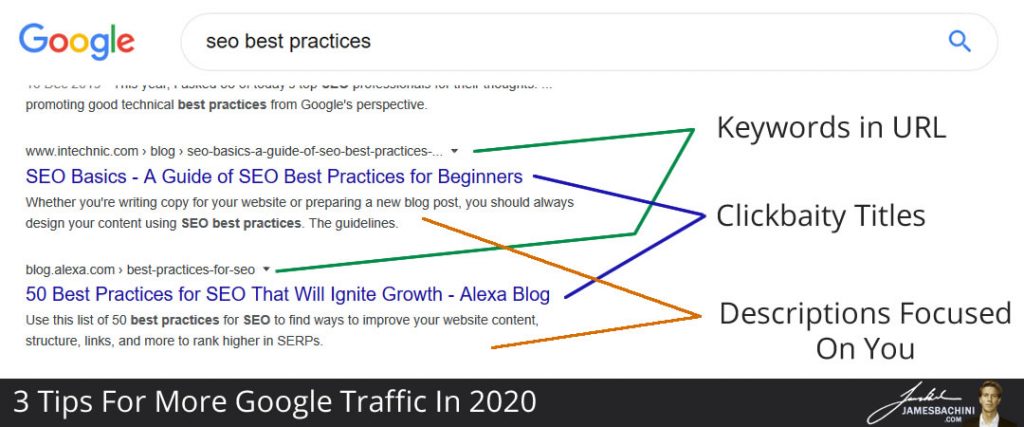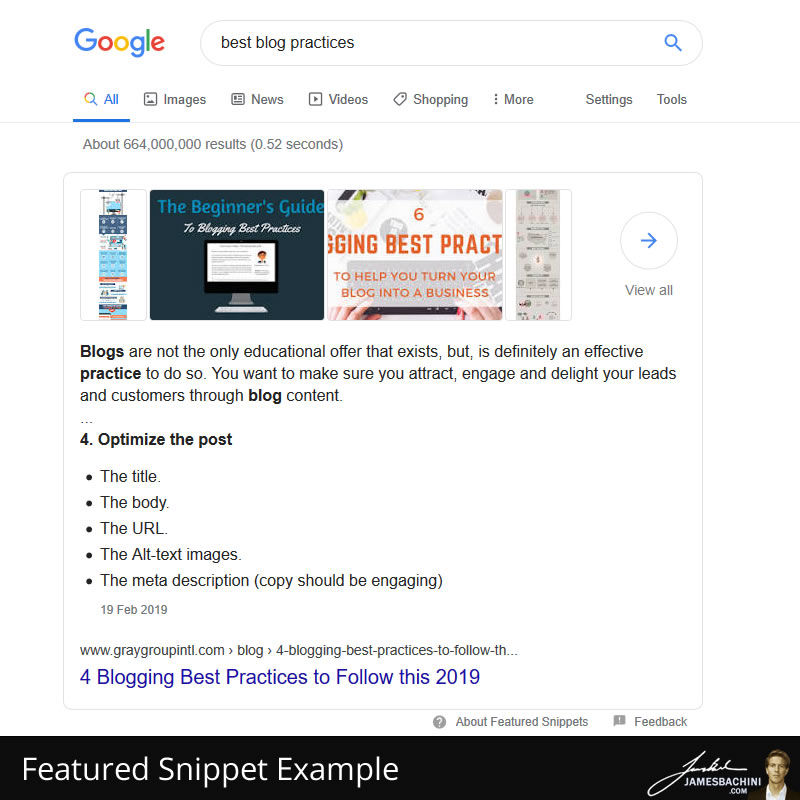This is the revised 2020 complete guide to the best practices when creating content for your blog. You can use this framework to create a “perfect blog post” and move your site up the search engine rankings.

The Title
The title or headline of a blog post should be a close match to a search query but also just clickbaity enough to get a higher click through rate than your competitors. Higher click through rate not only gets you more visitors based on the same number of searches but it also is a growing SEO ranking factor.
If two articles have similar search engine rankings then they will be placed next to each other. If one has the ability to get more clicks it will signal to Google that it is more relevant for that search query and will eventually end up higher up the rankings.
Click through rate is talked about as the key metric on Youtube (Google owned) but it’s still seen as second fiddle to backlinks in SEO circles. There’s no doubt that Google are recording the click-through rate on search results, the only debate is on how much weight they place on that metric. In my opinion it’s a lot.
The following tool can be used to generate title ideas. It was made by compiling a list of titles from search results for ultra-competitive terms.
Concepts To Write Better Blog Titles
- Write for the visitor! Include words like You and Your.
- Use proven headlines:
- Curated List “7 Simple Tricks To *”
- How To “How To *”
- Searchable Questions “Why does x?”
- Numbers generate clicks
- Emotional words push buttons “Confessions of a x”
- 50-60 characters works best
- Generate enough ambiguity to arouse interest
When targeting Google search results pages have a clear idea of how your post will get a significant percentage of the traffic for that query. For example if a authoritative site has the top position could you target a particular demographic of the traffic such as newbies with a title such as “The Ultimate Beginners Guide To X”
The Hook
If the title can generate enough ambiguity to earn a click from the search results then the hook should be placed directly below the headline and should catch and keep the visitors interest in one short paragraph.
The hook should confirm to the user that they made the right decision visiting your site and
short summary of what the article will cover and lead in to content. The author and/or article should be presented as the authoritative resource for the topic under discussion.
The blog post should be for the visitor and this needs to be articulated in the hook with words like you/your/you’re
The first 160 characters of the hook will also often be used as the description in the search results so it is important to sell your post as an authoritative and valuable resource.
Search Engine Presentation
Some consideration should be made to the SERPs (search engine results page) before you start your article.
Choose which search phrase or group of search phrases you are going to target and google it. Check the search results and what is currently ranking. Is it competitive and is there an opportunity to carve out a slice of that traffic?
Some keyword research resources:-
Once you have your keywords, a clickable title and a great hook you should have a compelling SERP listing like the following.

Structure
The perfect blog post should be comprised of small paragraphs. No one wants to read a huge block of text on a mobile phone or laptop. Generally aim for no more than 5 lines per paragraph and make one point.
Sub-headings should be used to structure the content of the post. If your posts are like mine where it tends to be a brain dump and rant then the sub-headings can be planned out ahead of time using mindmaps to develop the flow of the article before you start writing.
Tables, numbered lists and bullet points add visually appealing structured text
What we are aiming for is content that is scannable. A visitor should be able to scroll through the article and find the topic that most interests them and the information that they are looking for. Easy to read articles get read more often increasing time on site and reducing bounce rates which helps SEO rankings.
The length of the article is important for rankings. Aim for 2500 words, this is 8 pages roughly in Google docs. It’s a lot and hopefully you are writing about something you are interested in. 2500 words is the average length of posts for highly competitive terms. Google wants definitive, authoritative content to give to its users.
Tip. Go to Amazon and search for whatever you are writing about. Use the “look inside” preview to go through the contents pages to find topics to write about. Go through a few books in the niche and plan out the topics for your sub-headings before you start writing.
Video
If you have the ability, resources and time to create a video around the topic of your blog post then this can help in a number of ways.
- Youtube is the number one site for driving traffic in 2020. This can promote your blog post which will be linked to in the description but is also a great discovery platform for your brand.
- Once on Youtube you can embed it in your blog post which adds rich media and helps SEO. It also adds personality and authority to your site if someone can see the article isn’t written by a virtual assistant.
A simple “talking head” Youtube video can be created in an hour.
I’d highly recommend OBS for recording and DaVinci for editing. These are both free programs.
You’ll need a webcam or modern smartphone and a USB microphone. The microphone is critical as audio is far more important than video quality.
Tip: Don’t try and get it perfect in one take. Just cut out mistakes using the audio waveform to see where to cut. If you start to waffle or make an error while recording just stop and start again from the last sentence or break.
Linkable Content
Good organic backlinks are hard to come by. If you buy them then you risk doing more damage than good as many vendors just sell links on private blog networks or worse. The best long-term strategy is to create linkable content.
Linkable content can include but is not limited to:-
- Original Research
- Stats and figures
- Graphs and charts
- Infographics
- Memes and images
- Shareable quotes
- Javascript Tools
- PDF documents
- Zip files
- Lead magnet type bonus material
- Curated lists of resources
- Lists
- Videos
What can you include that people would want to share on social media?
What can you include that people will want to quote and include a reference?
In wordpress there is an option for featured image under the posts document settings. This is important because it is the image that is used to generate the card for social media posts. It therefore plays a big part in the click through rate and amount of traffic received per social share.
For featured images I recommend following best practices for Youtube posts. Include a headline in the image with keywords and make the image intriguing enough raise enough interest to get the click
End with a Conclusion
At the end of the blog post we need to draw a conclusion. This is going to be targeting the featured snippet that gets listed at the top of the search engine results page for many queries.

The featured snippet can either be a paragraph, table or list and this is the format that the conclusion should follow.
- Paragraph – 40-97 word (3-8 lines at 11px)
- List – 4 to 8 bullet points
- Table – 2-3 columns 2-9 rows
Marketing
“Build it and they will come” works more like “build it and no one will care” in 2020. It’s essential for ambitious bloggers to carry out marketing for their blogs. The following methods can be used to create a seed audience, gather initial organic back links and social shares, establish authority and grow an audience.
You can tweet out your blog post and then use https://ads.twitter.com to promote the tweet. Do some initial research and find people in the same niche and note their twitter handles. These can then be used to build a targeted audience for your post.
Reddit can be used to reach an audience actively looking for content in your niche. Post in a relevant sub-reddit such as https://www.reddit.com/r/Blogging/
Youtube
Youtube ads can be run through https://ads.google.com to promote your video, gain subscribers and build your brand.
Linkedin ads can be expensive compared to other networks but there is a targetable niche of business users and if your company or blog is relevant to that demographic it could be a good choice.
Linkedin can also be used to connect organically and then post quality content to the feed.
Facebook ads have laser targeting. You can target men, aged 35, living in a particular village who have an anniversary in the next 60 days. CPM’s are high but the volume and targeting make it an exceptional traffic source.
Google ads can be split in to search text ads and display network banners. Search ads should be set up for your target search phrases that you want to reach organically. This will give you seed traffic and insights into volumes and potential leads/sales/revenues from ranking for that term.
With any traffic source the more work you put in the more effective your ad spend or time will be. It can be a struggle to gain some initial traction but once you have something working you can reuse the method for future blog posts with ease.
Conclusion
These 8 tips will help you create the perfect blog post
- Start with a clickable title
- Create a hook to capture attention and sell the post
- Plan the target search terms and search engine presentation
- Structure your content so it is scannable and easy to read
- If possible make a video to go alongside your blog post
- Create linkable content such as stats, infographics and quotes
- Draw a conclusion to target the featured snippets box
- Market your blog post with paid ads and organic outreach


